Seat Leon 5D 2006 Maintenance programme
Manufacturer: SEAT, Model Year: 2006, Model line: Leon 5D, Model: Seat Leon 5D 2006Pages: 292, PDF Size: 8.86 MB
Page 11 of 292
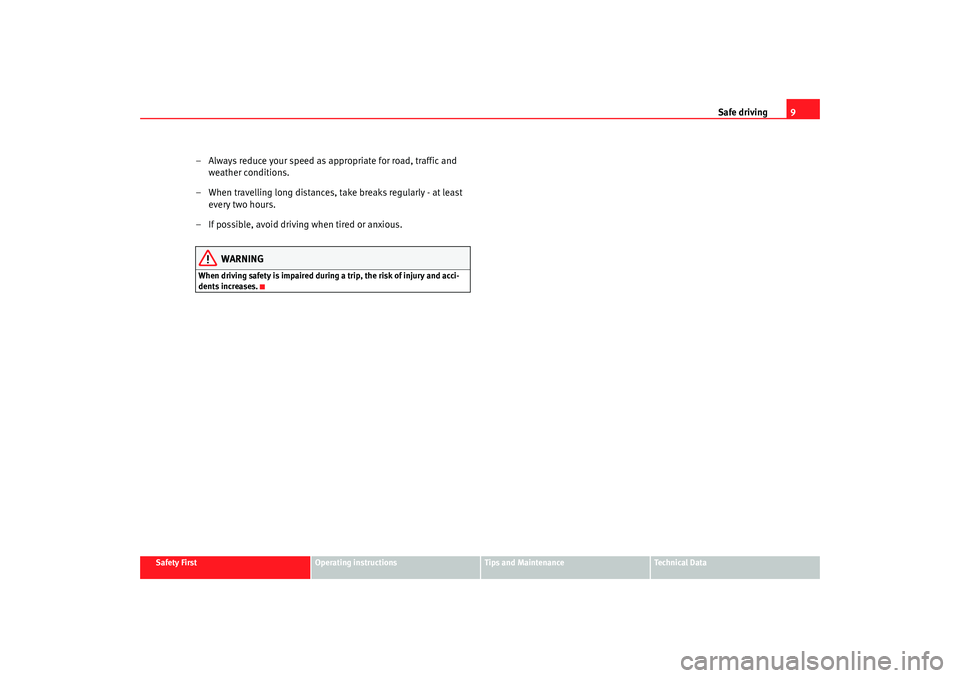
Safe driving9
Safety First
Operating instructions
Tips and Maintenance
Te c h n i c a l D a t a
– Always reduce your speed as appropriate for road, traffic and
weather conditions.
– When travelling long distances, take breaks regularly - at least every two hours.
– If possible, avoid driving when tired or anxious.
WARNING
When driving safety is impaired during a trip, the risk of injury and acci-
dents increases.
leon_ingles Seite 9 Donnerstag, 24. August 2006 1:56 13
Page 12 of 292

Safe driving
10Proper sitting position for occupantsProper sitting position for driver
The proper sitting position for the driver is important for safe
and relaxed driving.
For your own safety and to reduce the risk of injur y in the event of an
accident, we recommend the following adjustments for the driver:
– Adjust the steering wheel so that there is a distance of at least
25 cm between the steering wheel and the centre of your chest
⇒fig. 1.
– Move the driver's seat forwards or backwards so that you are able to press the accelerator, brake and clutch pedals to the floor with
your knees still slightly angled ⇒.
– Ensure that you can reach the highest point of the steering wheel.
– Adjust the head restraint so that its upper edge is at the same level as the top of your head, or as close as possible to the same
level as the top of your head ⇒fig. 2.
– Move the backrest to an upright position so that your back rests completely against it.
Fig. 1 The proper
distance between driver
and steering wheel
Fig. 2 Proper head
restraint position for
driver
leon_ingles Seite 10 Donner stag, 24. August 2006 1:56 13
Page 13 of 292
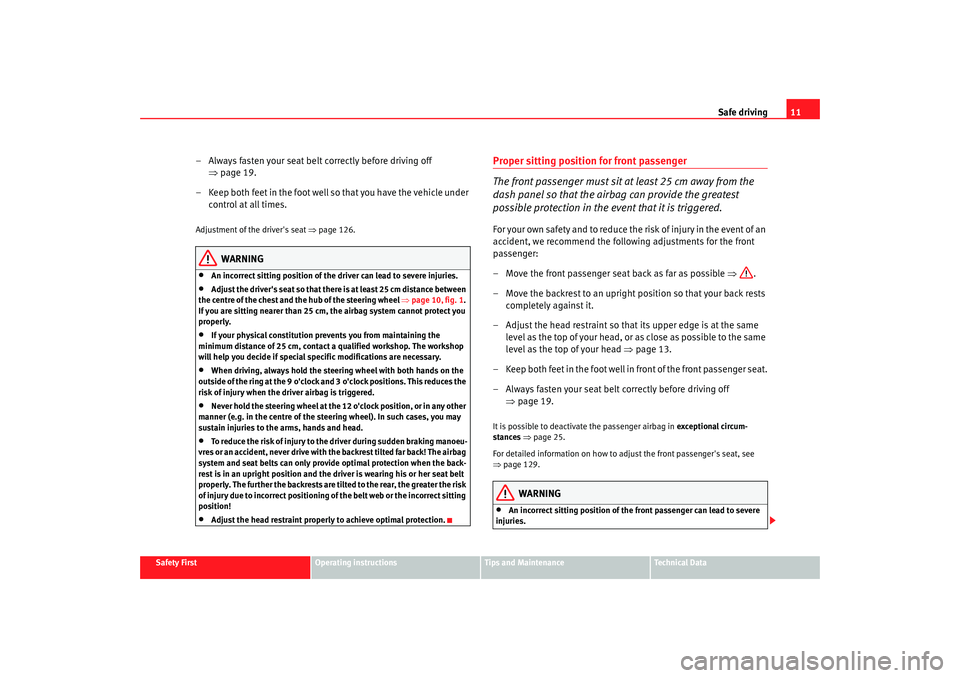
Safe driving11
Safety First
Operating instructions
Tips and Maintenance
Te c h n i c a l D a t a
– Always fasten your seat belt correctly before driving off
⇒page 19.
– Keep both feet in the foot well so that you have the vehicle under control at all times.Adjustment of the driver's seat ⇒page 126.
WARNING
•
An incorrect sitting position of the driver can lead to severe injuries.
•
Adjust the driver's seat so that ther e is at least 25 cm distance between
the centre of the chest and the hub of the steering wheel ⇒page 10, fig. 1 .
If you are sitting nearer than 25 cm, the airbag system cannot protect you
properly.
•
If your physical constitution prevents you from maintaining the
minimum distance of 25 cm, contact a qualified workshop. The workshop
will help you decide if special specific modifications are necessary.
•
When driving, always hold the steering wheel with both hands on the
outside of the ring at the 9 o'clock and 3 o'clock positions. This reduces the
risk of injury when the driver airbag is triggered.
•
Never hold the steering wheel at the 12 o'clock position, or in any other
manner (e.g. in the centre of the steering wheel). In such cases, you may
sustain injuries to the arms, hands and head.
•
To reduce the risk of injury to the driver during sudden braking manoeu-
vres or an accident, never drive with the backrest tilted far back! The airbag
system and seat belts can only provide optimal protection when the back-
rest is in an upright position and the driver is wearing his or her seat belt
properly. The further the backrests are ti lted to the rear, the greater the risk
of injury due to incorrect positioning of the belt web or the incorrect sitting
position!
•
Adjust the head restraint properly to achieve optimal protection.
Proper sitting position for front passenger
The front passenger must sit at least 25 cm away from the
dash panel so that the airbag can provide the greatest
possible protection in the event that it is triggered.For your own safety and to reduce the risk of injury in the event of an
accident, we recommend the following adjustments for the front
passenger:
– Move the front passenger seat back as far as possible ⇒ .
– Move the backrest to an upright position so that your back rests completely against it.
– Adjust the head restraint so that its upper edge is at the same level as the top of your head, or as close as possible to the same
level as the top of your head ⇒page 13.
– Keep both feet in the foot well in front of the front passenger seat.
– Always fasten your seat belt correctly before driving off ⇒page 19.It is possible to deactivate the passenger airbag in exceptional circum-
stances ⇒ page 25.
For detailed information on how to adjust the front passenger's seat, see
⇒ page 129.
WARNING
•
An incorrect sitting position of the front passenger can lead to severe
injuries.
leon_ingles Seite 11 Donner stag, 24. August 2006 1:56 13
Page 14 of 292
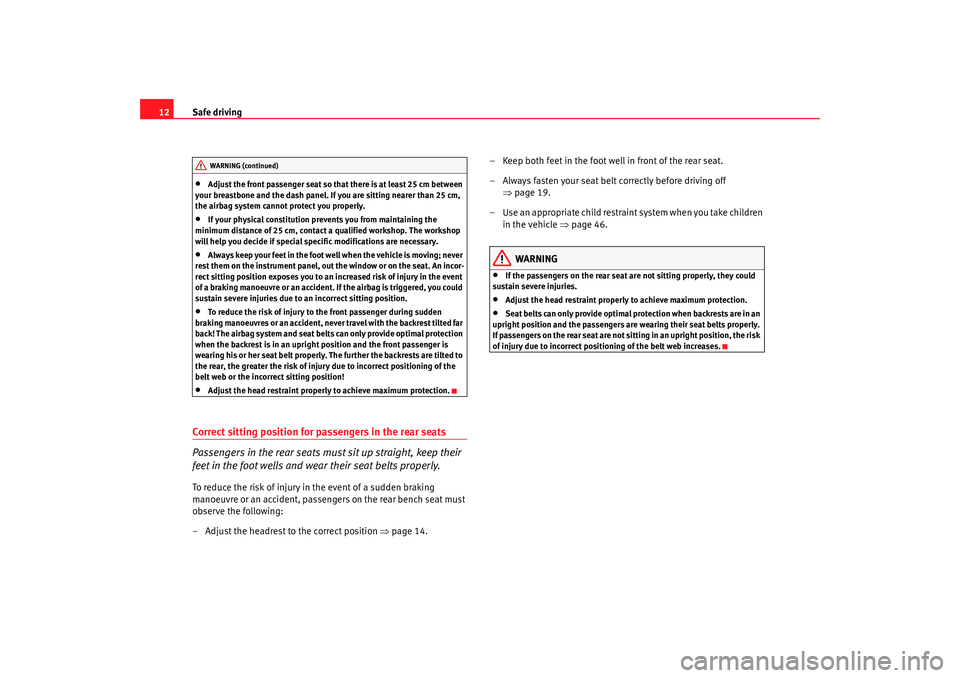
Safe driving
12•
Adjust the front passenger seat so th at there is at least 25 cm between
your breastbone and the dash panel. If you are sitting nearer than 25 cm,
the airbag system cannot protect you properly.
•
If your physical constitution prevents you from maintaining the
minimum distance of 25 cm, contact a qualified workshop. The workshop
will help you decide if special specific modifications are necessary.
•
Always keep your feet in the foot well when the vehicle is moving; never
rest them on the instrument panel, out the window or on the seat. An incor-
rect sitting position exposes you to an increased risk of injury in the event
of a braking manoeuvre or an accident. If the airbag is triggered, you could
sustain severe injuries due to an incorrect sitting position.
•
To reduce the risk of injury to the front passenger during sudden
braking manoeuvres or an accident, never travel with the backrest tilted far
back! The airbag system and seat belts can only provide optimal protection
when the backrest is in an upright position and the front passenger is
wearing his or her seat belt properly. The further the backrests are tilted to
the rear, the greater the risk of injury due to incorrect positioning of the
belt web or the incorrect sitting position!
•
Adjust the head restraint properly to achieve maximum protection.
Correct sitting position for passengers in the rear seats
Passengers in the rear seats must sit up straight, keep their
feet in the foot wells and wear their seat belts properly.To reduce the risk of injury in the event of a sudden braking
manoeuvre or an accident, passengers on the rear bench seat must
observe the following:
– Adjust the headrest to the correct position ⇒page 14. – Keep both feet in the foot well in front of the rear seat.
– Always fasten your seat belt correctly before driving off
⇒page 19.
– Use an appropriate child restraint system when you take children in the vehicle ⇒page 46.
WARNING
•
If the passengers on the rear seat are not sitting properly, they could
sustain severe injuries.
•
Adjust the head restraint properly to achieve maximum protection.
•
Seat belts can only provide optimal protection when backrests are in an
upright position and the passengers ar e wearing their seat belts properly.
If passengers on the rear seat are not sitting in an upright position, the risk
of injury due to incorrect positioning of the belt web increases.
WARNING (continued)
leon_ingles Seite 12 Donner stag, 24. August 2006 1:56 13
Page 15 of 292
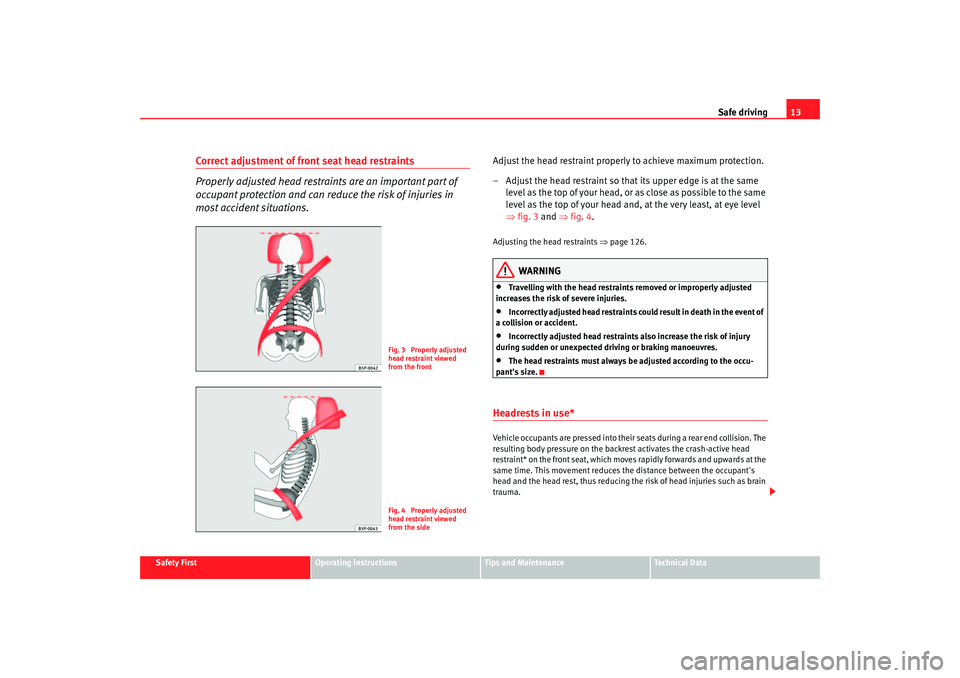
Safe driving13
Safety First
Operating instructions
Tips and Maintenance
Te c h n i c a l D a t a
Correct adjustment of front seat head restraints
Properly adjusted head restraints are an important part of
occupant protection and can redu ce the risk of injuries in
most accident situations.
Adjust the head restraint properly to achieve maximum protection.
– Adjust the head restraint so that its upper edge is at the same
level as the top of your head, or as close as possible to the same
level as the top of your head and, at the very least, at eye level
⇒fig. 3 and ⇒ fig. 4.Adjusting the head restraints ⇒page 126.
WARNING
•
Travelling with the head restrain ts removed or improperly adjusted
increases the risk of severe injuries.
•
Incorrectly adjusted head restraints could result in death in the event of
a collision or accident.
•
Incorrectly adjusted head restraints also increase the risk of injury
during sudden or unexpected driving or braking manoeuvres.
•
The head restraints must always be adjusted according to the occu-
pant's size.
Headrests in use*Vehicle occupants are pressed into their seats during a rear end collision. The
resulting body pressure on the backrest activates the crash-active head
restraint* on the front seat, which moves rapidly forwards and upwards at the
same time. This movement reduces the distance between the occupant's
head and the head rest, thus reducing the risk of head injuries such as brain
trauma.
Fig. 3 Properly adjusted
head restraint viewed
from the frontFig. 4 Properly adjusted
head restraint viewed
from the side
leon_ingles Seite 13 Donner stag, 24. August 2006 1:56 13
Page 16 of 292
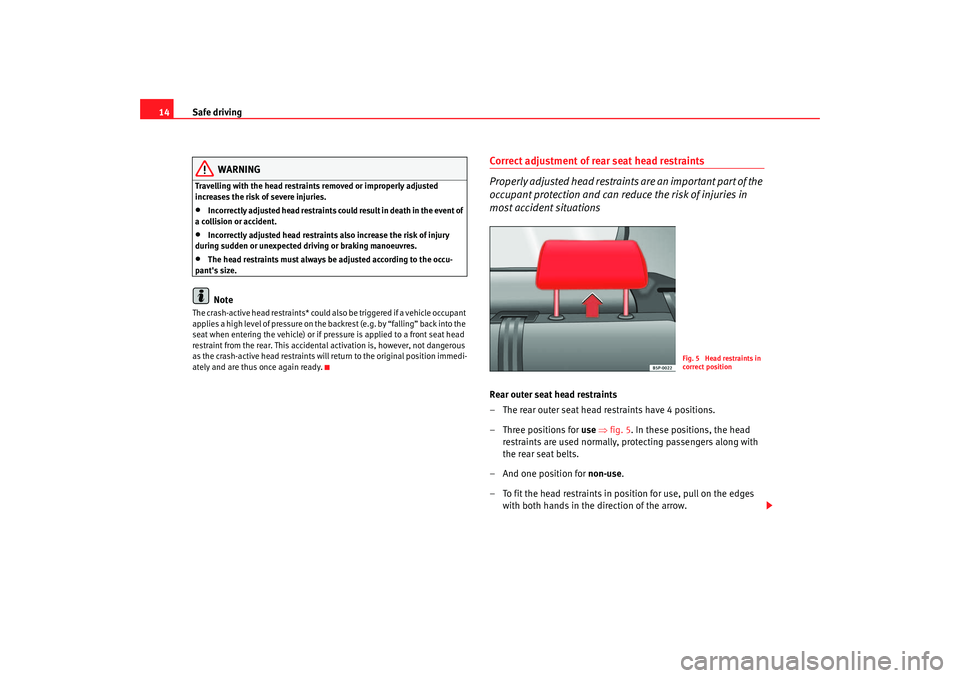
Safe driving
14
WARNING
Travelling with the head restraints removed or improperly adjusted
increases the risk of severe injuries.•
Incorrectly adjusted head restraints could result in death in the event of
a collision or accident.
•
Incorrectly adjusted head restraints also increase the risk of injury
during sudden or unexpected driving or braking manoeuvres.
•
The head restraints must always be adjusted according to the occu-
pant's size.Note
The crash-active head restraints* could also be triggered if a vehicle occupant
applies a high level of pressure on the backrest (e.g. by “falling” back into the
seat when entering the vehicle) or if pressure is applied to a front seat head
restraint from the rear. This accidental activation is, however, not dangerous
as the crash-active head restraints will return to the original position immedi-
ately and are thus once again ready.
Correct adjustment of rear seat head restraints
Properly adjusted head restraints are an important part of the
occupant protection and can redu ce the risk of injuries in
most accident situationsRear outer seat head restraints
– The rear outer seat head restraints have 4 positions.
–Three positions for use ⇒ fig. 5. In these positions, the head
restraints are used normally, protecting passengers along with
the rear seat belts.
– And one position for non-use.
– To fit the head restraints in position for use, pull on the edges with both hands in the direction of the arrow.
Fig. 5 Head restraints in
correct position
leon_ingles Seite 14 Donner stag, 24. August 2006 1:56 13
Page 17 of 292
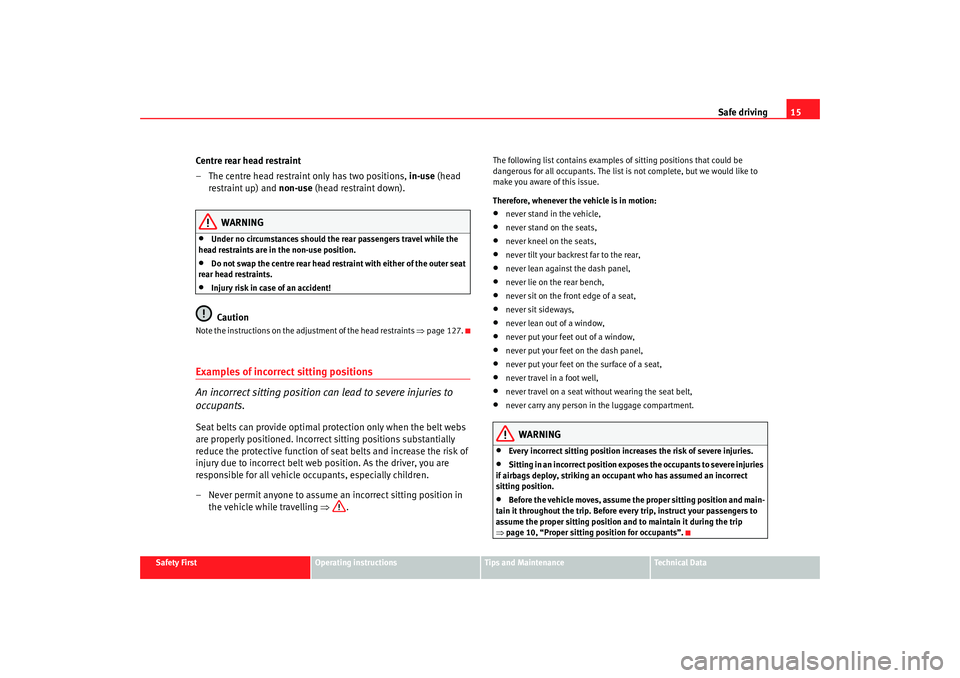
Safe driving15
Safety First
Operating instructions
Tips and Maintenance
Te c h n i c a l D a t a
Centre rear head restraint
– The centre head restraint only has two positions, in-use (head
restraint up) and non-use (head restraint down).
WARNING
•
Under no circumstances should the rear passengers travel while the
head restraints are in the non-use position.
•
Do not swap the centre rear head restraint with either of the outer seat
rear head restraints.
•
Injury risk in case of an accident!Caution
Note the instructions on the adjustment of the head restraints ⇒page 127.Examples of incorrect sitting positions
An incorrect sitting position can lead to severe injuries to
occupants.Seat belts can provide optimal protection only when the belt webs
are properly positioned. Incorrect sitting positions substantially
reduce the protective function of seat belts and increase the risk of
injury due to incorrect belt web position. As the driver, you are
responsible for all vehicle occupants, especially children.
– Never permit anyone to assume an incorrect sitting position in
the vehicle while travelling ⇒.
The following list contains examples of sitting positions that could be
dangerous for all occupants. The list is not complete, but we would like to
make you aware of this issue.
Therefore, whenever the vehicle is in motion:• never stand in the vehicle,• neve r stand on the seats,• never kneel on the seats,• never tilt your backrest far to the rear,• neve r lean against the dash panel,• never lie on the rear bench,• never sit on the front edge of a seat,• never sit sideways,• never lean out of a window,• never put your feet out of a window,• neve r put your fe et on the dash panel,• neve r put your fe et on the surface of a seat,• never travel in a foot well,• never travel on a seat without wearing the seat belt,• neve r carry any person in the luggage compartment.
WARNING
•
Every incorrect sitting position increases the risk of severe injuries.
•
Sitting in an incorrect position exposes the occupants to severe injuries
if airbags deploy, striking an occupant who has assumed an incorrect
sitting position.
•
Before the vehicle moves, assume the proper sitting position and main-
tain it throughout the trip. Before every trip, instruct your passengers to
assume the proper sitting position and to maintain it during the trip
⇒ page 10, “Proper sitting position for occupants”.
leon_ingles Seite 15 Donner stag, 24. August 2006 1:56 13
Page 18 of 292
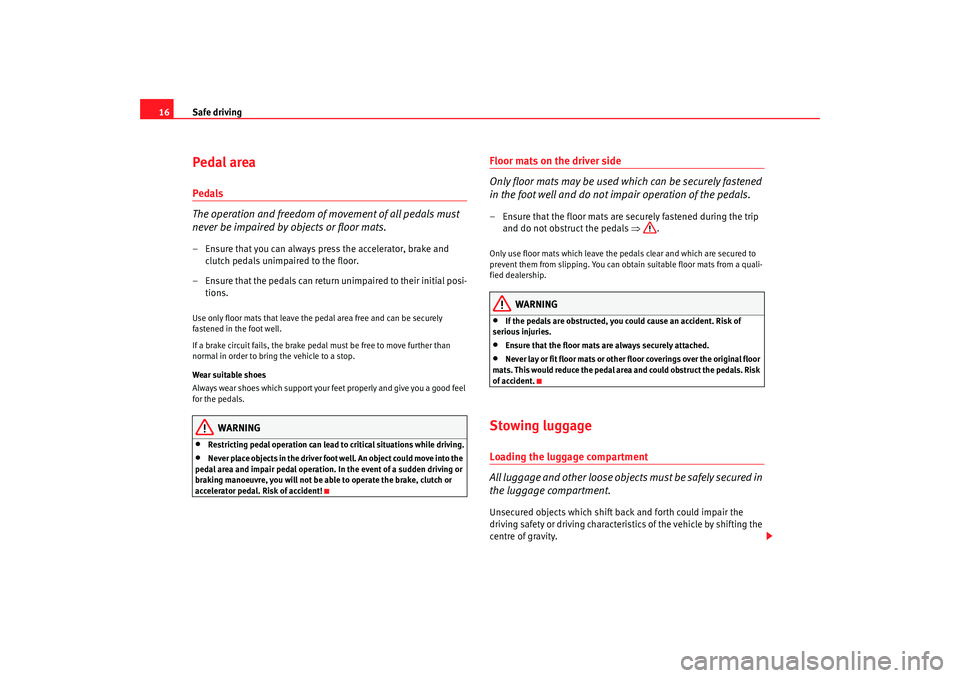
Safe driving
16Pedal areaPedals
The operation and freedom of movement of all pedals must
never be impaired by objects or floor mats.– Ensure that you can always press the accelerator, brake and
clutch pedals unimpaired to the floor.
– Ensure that the pedals can return unimpaired to their initial posi- tions.Use only floor mats that leave the pedal area free and can be securely
fastened in the foot well.
If a brake circuit fails, the brake pedal must be free to move further than
normal in order to bring the vehicle to a stop.
Wear suitable shoes
Always wear shoes which support your feet properly and give you a good feel
for the pedals.
WARNING
•
Restricting pedal operation can lead to critical situations while driving.
•
Never place objects in the driver foot well. An object could move into the
pedal area and impair pedal operation. In the event of a sudden driving or
braking manoeuvre, you will not be ab le to operate the brake, clutch or
accelerator pedal. Risk of accident!
Floor mats on the driver side
Only floor mats may be used which can be securely fastened
in the foot well and do not impair operation of the pedals.– Ensure that the floor mats are securely fastened during the trip and do not obstruct the pedals ⇒.Only use floor mats which leave the pedals clear and which are secured to
prevent them from slipping. You can obta in suitable floor mats from a quali-
fied dealership.
WARNING
•
If the pedals are obstructed, you could cause an accident. Risk of
serious injuries.
•
Ensure that the floor mats are always securely attached.
•
Never lay or fit floor mats or other floor coverings over the original floor
mats. This would reduce the pedal area and could obstruct the pedals. Risk
of accident.
Stowing luggageLoading the luggage compartment
All luggage and other loose objects must be safely secured in
the luggage compartment.Unsecured objects which shift back and forth could impair the
driving safety or driving characteristics of the vehicle by shifting the
centre of gravity.
leon_ingles Seite 16 Donner stag, 24. August 2006 1:56 13
Page 19 of 292
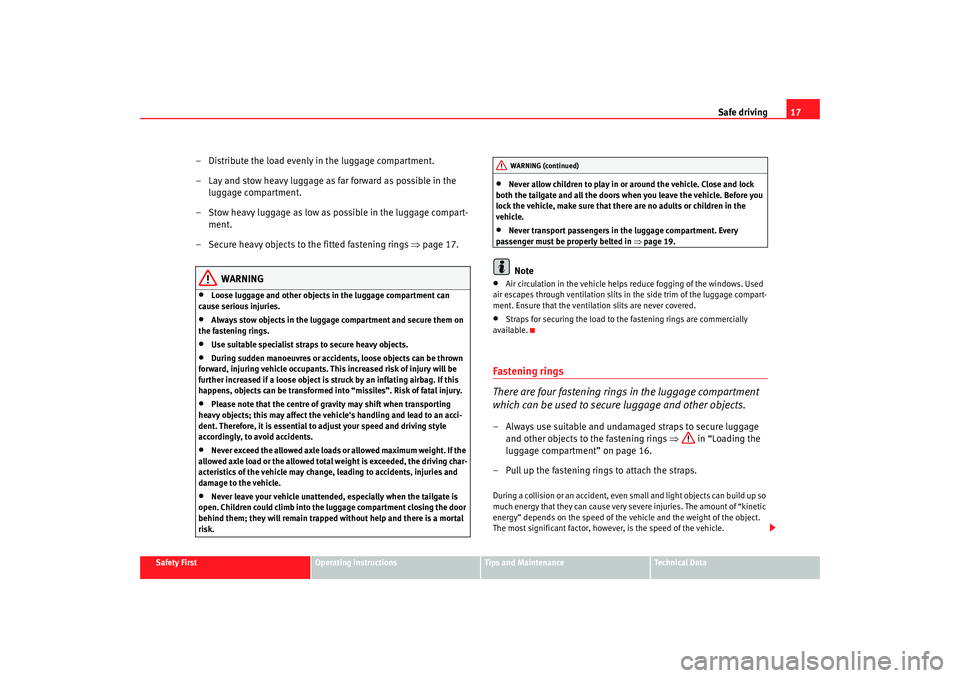
Safe driving17
Safety First
Operating instructions
Tips and Maintenance
Te c h n i c a l D a t a
– Distribute the load evenly in the luggage compartment.
– Lay and stow heavy luggage as far forward as possible in the luggage compartment.
– Stow heavy luggage as low as possible in the luggage compart- ment.
– Secure heavy objects to the fitted fastening rings ⇒page 17.
WARNING
•
Loose luggage and other objects in the luggage compartment can
cause serious injuries.
•
Always stow objects in the luggage compartment and secure them on
the fastening rings.
•
Use suitable specialist straps to secure heavy objects.
•
During sudden manoeuvres or accidents, loose objects can be thrown
forward, injuring vehicle occupants. This increased risk of injury will be
further increased if a loose object is struck by an inflating airbag. If this
happens, objects can be transformed into “missiles”. Risk of fatal injury.
•
Please note that the centre of gravity may shift when transporting
heavy objects; this may affect the vehicle's handling and lead to an acci-
dent. Therefore, it is essential to adjust your speed and driving style
accordingly, to avoid accidents.
•
Never exceed the allowed axle loads or allowed maximum weight. If the
allowed axle load or the allowed total weight is exceeded, the driving char-
acteristics of the vehicle may change, leading to accidents, injuries and
damage to the vehicle.
•
Never leave your vehicle unattended, especially when the tailgate is
open. Children could climb into the luggage compartment closing the door
behind them; they will remain trapped without help and there is a mortal
risk.
•
Never allow children to play in or around the vehicle. Close and lock
both the tailgate and all the doors when you leave the vehicle. Before you
lock the vehicle, make sure that ther e are no adults or children in the
vehicle.
•
Never transport passengers in the luggage compartment. Every
passenger must be properly belted in ⇒ page 19.Note
•
Air circulation in the vehicle helps reduce fogging of the windows. Used
air escapes through ventilation slits in the side trim of the luggage compart-
ment. Ensure that the ventil ation slits are never covered.
•
Straps for securing the load to the fastening rings are commercially
available.
Fastening rings
There are four fastening rings in the luggage compartment
which can be used to secure luggage and other objects.– Always use suitable and undamaged straps to secure luggage and other objects to the fastening rings ⇒ in “Loading the
luggage compartment” on page 16.
– Pull up the fastening rings to attach the straps.During a collision or an accident, even small and light objects can build up so
much energy that they can cause very severe injuries. The amount of “kinetic
energy” depends on the speed of the vehicle and the weight of the object.
The most significant factor, however, is the speed of the vehicle.
WARNING (continued)
leon_ingles Seite 17 Donner stag, 24. August 2006 1:56 13
Page 20 of 292
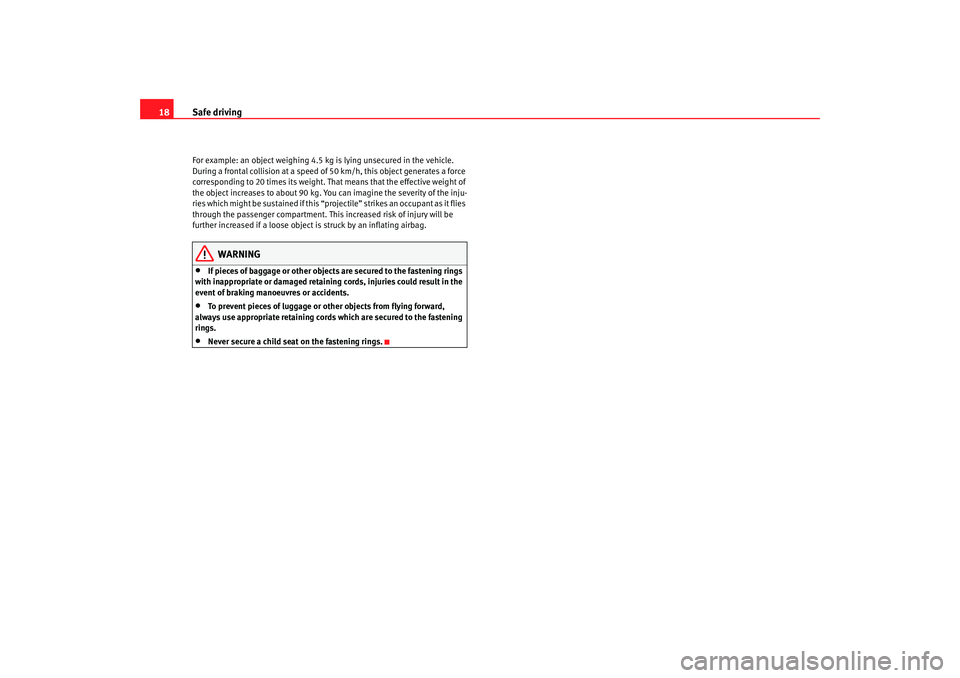
Safe driving
18For example: an object weighing 4.5 kg is lying unsecured in the vehicle.
During a frontal collision at a speed of 50 km/h, this object generates a force
corresponding to 20 times its weight. That means that the effective weight of
the object increases to about 90 kg. You can imagine the severity of the inju-
ries which might be sustaine d if this “projectile” strikes an occupant as it flies
through the passenger compartment. This increased risk of injury will be
further increased if a loose object is struck by an inflating airbag.
WARNING
•
If pieces of baggage or other objects are secured to the fastening rings
with inappropriate or damaged retaining cords, injuries could result in the
event of braking manoeuvres or accidents.
•
To prevent pieces of luggage or other objects from flying forward,
always use appropriate retaining cords which are secured to the fastening
rings.
•
Never secure a child seat on the fastening rings.
leon_ingles Seite 18 Donner stag, 24. August 2006 1:56 13